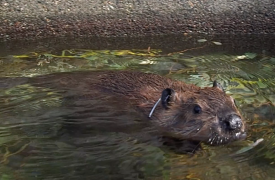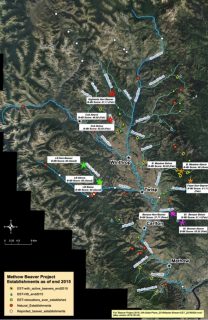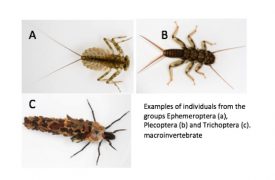by Anna Shampain, University of Puget Sound ’18
Major: Biology and Environmental Policy & Decision Making
Advisors:
Peter Wimberger, Director, Slater Museum of Natural History, Albertson Professor, Biology and Environmental Policy & Decision Making
Kena Fox- Dobbs, Associate Professor, Geology and Environmental Policy & Decision Making

In the western United States, riparian zones comprise less than one percent of the total land area, yet are some of the most productive habitats per area (Arthington et al. 2010). In the Pacific Northwest, riparian zones are an essential part of the life cycle of many species, including salmon, an economic, ecological, and socially significant keystone species. Beavers are also key inhabitants of riparian ecosystems due to their role as ecosystem engineers. Through dam construction, beavers alter water flow, temperature, nutrient and groundwater storage, and increase the overall complexity of river systems (France 2000, Wohl 2013). As a result, beaver habitat modifications have been shown to increase the diversity and abundance of riparian flora and fauna (Russell et al. 1999, Cunningham et al. 2007).
Historically, beavers were abundant in most freshwater systems in North America. However, fur trapping and habitat degradation associated with logging drastically reduced beaver populations. Prior to European settlement in the 16th century, the population of North American beavers was estimated to be 60-400 million (Naiman et al. 1988, Wohl 2013). Presently, the estimated beaver population is around 6-12 million (Naiman et al. 1988,).
Recently, research focusing on beaver habitat modifications has increased due to their potential for mitigating climate change impacts and, in the Pacific Northwest, enhancing salmon habitat. Beaver dams can ameliorate drought impacts and stabilize snowpack melt through water sequestration in dam systems (Hood and Bayley 2008, Majerova et al. 2015, Hafen and Macfarlane 2016). These dams act like a sponge that holds water in riparian systems, increasing groundwater storage, and reducing peak flows. Furthermore, beaver dams serve as important nutrient storage systems within local habitats.

Figure 1. Map of survey streams within the Methow River watershed includes B-IBI (Benthic Index of Biotic Integrity) scores for each stream site. Stars indicate survey stream locations with paired locations of the same color. B-IBI scores are a quantitative standardized measurement system based in nine macroinvertebrate community metrics that indicate water and habitat quality. Each score corresponds to a condition (good, fair, or poor). Sum scores of B-IBI metric scoring system are represented above.
Aquatic macroinvertebrates, a group of small spineless animals that include various arthropod species and worms, play an integral role in freshwater ecosystems. Macroinvertebrates provide an important link in the riparian food web by processing organic materials, thus cycling nutrients and serving as a key food source for higher consumers like fish and amphibians. Different assemblages of macroinvertebrates respond uniquely to environmental conditions, making them bioindicators of watershed health (Wallace 1996). Macroinvertebrates are common in most freshwater systems, but have been shown to increase in diversity and abundance within beaver habitat (Clifford et al. 1993).
Our study examined the impacts of beaver-caused habitat alterations on the composition of local macroinvertebrate communities in the Methow Valley in north central Washington. The Methow Beaver Project, based out of Winthrop, Washington, has been re-introducing beavers on streams in the Methow River Watershed since 2009. The Methow Beaver Project’s goals are to improve the health of riparian ecosystems, enhance in-stream habitat necessary for historic salmon runs, and mitigate the impacts of climate change on annual water flow in the Methow River drainage (S. Bondi 2009, Woodruff, 2015).
We partnered with the Methow Beaver Project to locate streams actively inhabited by beavers in the watershed. In July 2017, we sampled macroinvertebrate communities on beaver-impacted streams above and below beaver dams, as well as on streams without known beaver presence. Aquatic and terrestrial plants and macroinvertebrates were collected from all streams for stable isotope analysis of carbon and nitrogen.
 We found that macroinvertebrate species known to be sensitive to impaired water quality were more abundant below beaver dams than above dams across all streams. Relative dominance, one measure of community diversity (lower percent dominance indicating more diverse communities), was lower below beaver dams than above dams. Furthermore, low oxygen-tolerant taxa (Diptera) were less abundant below beaver dams than above dams. Our data suggest a fine-scale relationship between beaver dams and stream macroinvertebrate communities, indicating that the presence of beavers increases local stream health. Furthermore, preliminary stable isotope analyses are suggestive of changes in nitrogen and carbon storage above and below beaver dams.
We found that macroinvertebrate species known to be sensitive to impaired water quality were more abundant below beaver dams than above dams across all streams. Relative dominance, one measure of community diversity (lower percent dominance indicating more diverse communities), was lower below beaver dams than above dams. Furthermore, low oxygen-tolerant taxa (Diptera) were less abundant below beaver dams than above dams. Our data suggest a fine-scale relationship between beaver dams and stream macroinvertebrate communities, indicating that the presence of beavers increases local stream health. Furthermore, preliminary stable isotope analyses are suggestive of changes in nitrogen and carbon storage above and below beaver dams.
In summary, our results suggest that beaver dams have ecosystem level impacts that improve stream health and increase the diversity of local macroinvertebrate communities.
For more information on the Methow Beaver Project, see: http://methowsalmon.org/beaverproject.html
References:
A.H. Arthington, Robert J. Naiman, Michael E. Mcclain, And Christer Nilsson. 2010. Preserving The Biodiversity And Ecological Services Of Rivers: New Challenges And Research Opportunities. Freshwater Biology:1–16.
Cunningham, J. M., A. J. K. Calhoun, And W. E. Glanz. 2007. Pond-Breeding Amphibian Species Richness And Habitat Selection In A Beaver-Modified Landscape. Journal Of Wildlife Management 71:2517–2526.
Glynnis A. Hood, And Suzanne E. Bayley. 2008. Beaver (Castor Canadensis) Mitigate The Effects Of Climate On The Area Of Open Water In Boreal Wetlands In Western Canada. Biological Conservation.
Hugh F. Clifford, Gillian M. Wiley, And Richard J. Casey. 1993. Macroinvertebrates Of A Beaver-Altered Boreal Stream Of Alberta, Canada, With Special Reference To The Fauna On The Dams. Canadian Journal Of Zoology 7.
J. Bruce Wallace. 1996. The Role Of Macroinvertebrates In Stream Ecosystem Function. Annual Review Of Entomology:115–139.
Konrad Hafen, And William W. Macfarlane. 2016. Can Beaver Dams Mitigate Water Scarcity Caused By Climate Change And Population Growth? Stream Notes:1–10.
M. Majerova, B. T. Neilson, N. M. Schmadel, J. M. Wheaton, And C. J. Snow. 2015. Impacts Of Beaver Dams On Hydrologic And Temperature Regimes In A Mountain Stream. Hydrology And Earth System Sciences:3541–3556.
Naiman, R. J., C. A. Johnston, And J. C. Kelley. 1988. Alteration Of North American Streams By Beaver. Bioscience 38:753–762.
Russell, K. R., C. E. Moorman, J. K. Edwards, B. S. Metts, And D. C. G. Jr. 1999. Amphibian And Reptile Communities Associated With Beaver (Castor Canadensis) Ponds And Unimpounded Streams In The Piedmont Of South Carolina. Journal Of Freshwater Ecology 14:149–158.
S. Bondi. 2009. Ecotrust Whole Watershed Restoration Project Completion Report: Salmon Habitat Enhancement Through Beaver Reintroduction, Methow Conservancy.
Wohl, E. 2013. Landscape-Scale Carbon Storage Associated With Beaver Dams. Geophysical Research Letters 40:3631–3636.









